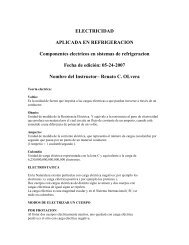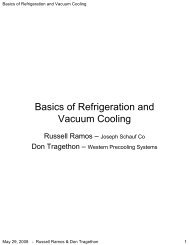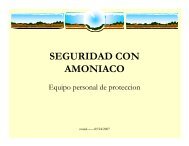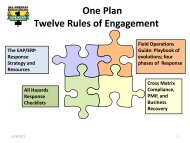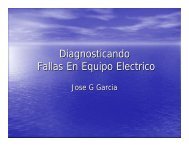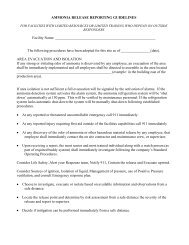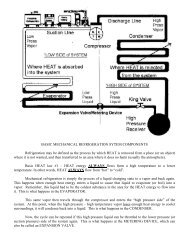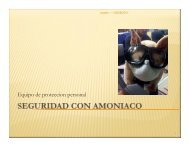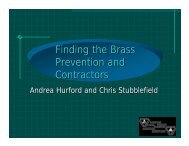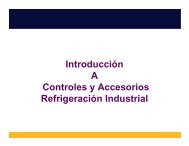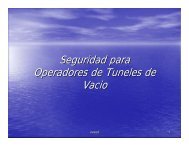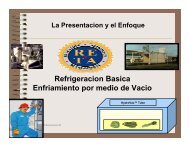Awareness Training Goals - Salinas Valley Ammonia Safety Day
Awareness Training Goals - Salinas Valley Ammonia Safety Day
Awareness Training Goals - Salinas Valley Ammonia Safety Day
You also want an ePaper? Increase the reach of your titles
YUMPU automatically turns print PDFs into web optimized ePapers that Google loves.
<strong>Ammonia</strong> <strong>Safety</strong> <strong>Day</strong><br />
13. What is SAL’s warning when large amounts of his vapor enter a confined room with no ventilation?<br />
What is needed for SAL to ignite into a powerful ball of flame? What’s this called?<br />
When vapors reach somewhere around 15% to 25% of a mixture in air (150,000 to 250,000 PPM) a source<br />
of ignition that is at least 1204 degrees F may ignite him into a powerful ball of flames called a “flash<br />
fire” or deflagration.<br />
14. What is SAL’s warning about water? Why is he more sensitive when water is dumped on him rather<br />
than for him to jump into the water?<br />
SAL doesn’t like to be startled with water being dumped on his cool liquid (water on an ammonia vapor is<br />
not the same, the vapor will attract to the water rapidly; but an aerosol or liquid is very hard to control<br />
with water – the vapors tend to become caustic and heavy, staying close to the ground); he is settled down<br />
and asleep and suddenly the hot flash of water will make him spit with anger; he likes water and is much<br />
more easy to control when he goes to water rather than vice versa.<br />
LANCE – The super hero!<br />
15. What does L.A.N.C.E. stand for?<br />
L = Life <strong>Safety</strong> – set the hot zone and check PPE<br />
A = Alert the response team and let those in the immediate area know that there is a problem<br />
N = Notify 9-1-1 by following your SOP<br />
C = Contain the release; close the door; when trained control the release if safe to do so<br />
E = Escape, Evacuate or Shelter In Place<br />
Injury Prevention & Health Concerns<br />
16. What does LANCE say regarding the value of PMP (Prevention, Mitigation, and Preparation)? What<br />
type of personal protective equipment (PPE) should an operator wear when working around the<br />
ammonia system? What’s the immediate area of concern should a problem develop while working on<br />
the system?<br />
The best way to stop an emergency is to prevent it from occurring; operators should wear full skin<br />
protection, radio, ammonia monitor, gloves, respirator (or face shield or chemical safe unvented goggles);<br />
10 to 15 feet of immediate impact from a sudden release.<br />
17. What is the lowest level that most people can smell ammonia? What is the PEL for SAL? _______<br />
PPM and what does that mean? What is the IDLH: ______ PPM and what does that mean?<br />
The odor of ammonia can be as low as 5 PPM as far away as a mile downwind (olfactory fatigue or<br />
damaged nose sensors would reduce the potential to smell small amounts of ammonia). The PEL is 25<br />
PPM in California and a few other states; the PEL is the point at which everyone should evacuate except<br />
those trained and equipped to handle the emergency event; the IDLH is 300 PPM (survivable but very<br />
uncomfortable); the level of PPE must move to self contained breathing apparatus and a chemical resistant<br />
suit.<br />
Evacuation and Emergency Medical<br />
18. What’s the biggest worry associated with approaching an ammonia cloud? Identify three choices you<br />
have when escaping an ammonia release that continues to get worse (stronger and more irritating<br />
odor)? Identify three different emergency response leaders you would attempt to contact should you be<br />
trapped inside and unable to escape an ammonia release? How would you communicate with them if<br />
©ASTI – www.ammonia-safety.com – August 2008 31




